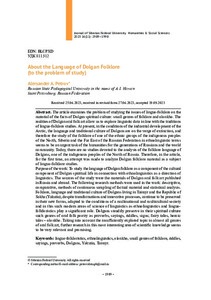О языке фольклора долган (к проблеме изучения)
Автор:
Петров, А. А.
Petrov, Alersander A.
Дата:
2023-11Журнал:
Журнал Сибирского федерального университета. Гуманитарные науки. Journal of Siberian Federal University. Humanities & Social Sciences; 2023 16 (11)Аннотация:
Исследуется изучение лингвофольклористики на материале фактов
духовной культуры долган: малых жанров фольклора и олонхо. Реалии устного
народного творчества долган позволяют исследовать языковые данные в русле традиций
лингвофольклористики. В настоящее время, в условиях промышленного освоения
Арктики, язык и традиционная культура долган находятся на грани исчезновения,
и потому изучение фольклора одного из этносов коренных малочисленных
народов Севера, Сибири и Дальнего Востока РФ в этнолингвистическом плане
представляется актуальной задачей гуманитарной науки для поколений россиян
и мирового сообщества. Сегодня отсутствуют исследования, посвящённые анализу
языка фольклора долган – одного из коренных малочисленных народов Севера
России. Поэтому в статье впервые предпринята попытка анализа фольклорного
материала долган как предмета лингвофольклористики. Источниками исследования
послужили опубликованные в России и за рубежом материалы устного народного
творчества долган.
Фольклор, язык и традиционная культура долган Таймыра и Республики Саха
(Якутия), несмотря на трансформации и инновационные процессы, продолжают
сохраняться в их новых формах, адаптированных в условиях многонационального
и поликультурного общества, и в этом значительную роль играют такие современные
направления языкознания, как этнолингвистика и лингвофольклористика. Долганы
устойчиво сохраняют в своей духовной культуре такие жанры устного народного
поэтического творчества, как пословицы, поговорки, загадки, приметы, сказки,
героические сказания – олонхо. Учитывая малоисследованность темы почти во всех
жанрах устного народного творчества, дальнейшие изыскания в этой интереснейшей
области научного знания представляются весьма актуальными и перспективными The article examines the problem of studying the issues of linguo-folklore on the material of the facts of Dolgan spiritual culture: small genres of folklore and olonkho. The realities of Dolgan oral folk art allow us to explore linguistic data in line with the traditions of linguo-folklore studies. At present, in the conditions of the industrial development of the Arctic, the language and traditional culture of Dolgans are on the verge of extinction, and therefore the study of the folklore of one of the ethnic groups of the indigenous peoples of the North, Siberia and the Far East of the Russian Federation in ethnolinguistic terms seems to be an urgent task of the humanities for the generations of Russians and the world community. Today, there are no studies devoted to the analysis of the folklore language of Dolgans, one of the indigenous peoples of the North of Russia. Therefore, in the article, for the first time, an attempt was made to analyze Dolgan folklore material as a subject of linguo-folklore studies.
Purpose of the work: To study the language of Dolgan folklore as a component of the cultural component of Dolgan spiritual life in connection with ethnolinguistics as a direction of linguistics. The sources of the study were the materials of Dolgan oral folk art published in Russia and abroad. The following research methods were used in the work: descriptive, comparative, methods of continuous sampling of factual material and statistical analysis.
Folklore, language and traditional culture of Dolgans living in Taimyr and the Republic of Sakha (Yakutia), despite transformations and innovative processes, continue to be preserved in their new forms, adapted to the conditions of a multinational and multicultural society and in this such modern areas of science of linguistics as ethnolinguistics and linguo-folkloristics play a significant role. Dolgans steadily preserve in their spiritual culture such genres of oral folk poetry as proverbs, sayings, riddles, signs; fairy tales, heroic tales – olonkho. Taking into account the insufficiently explored topic in almost all genres of oral folk art, further research in this most interesting area of scientific knowledge seems to be very relevant and promising

